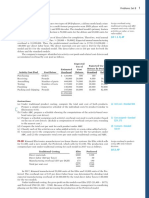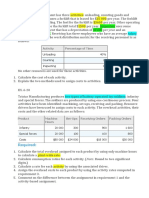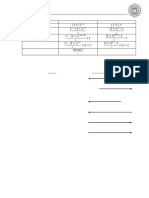Assignment 3
Uploaded by
solomon adamuAssignment 3
Uploaded by
solomon adamuMaryland International College
School of Graduate Studies
Accounting and Finance for Managers Assignment
----------------------------------------------------------------------------------------------------------------
Full Name (including your Grandfather’s name):……………………………………
General Instruction
1. Cheating is strictly forbidden.
2. Submission deadline: October 21/2021
3. Send your answers via the email: micmbaafm@gmail.com
Maryland International College Page 1
1. Weston Corporation manufactures a product that is available in both a deluxe and a regular
model. The company has made the regular model for years; the deluxe model was introduced
several years ago to tap a new segment of the market. Since introduction of the deluxe model,
the company’s profits have steadily declined. Sales of the deluxe model have been increasing
rapidly. Overhead is applied to products on the basis of direct labor-hours. At the beginning of
the current year, management estimated that $3,080,000 in overhead costs would be incurred
and the company would produce and sell 10,000 units of the deluxe model and 50,000 units of
the regular model. The deluxe model requires 2.0 hours of direct labor time per unit, and the
regular model requires 1.0 hours. Materials and labor costs per unit are given below:
Deluxe Regular
Direct materials cost per unit $50.00 $30.00
Direct labor cost per unit $30.00 $15.00
Required:
a. Compute the predetermined overhead rate using direct labor-hours as the basis for allocating
overhead costs to products. Compute the unit product cost for one unit of each model. An intern
suggested that the company use activity-based costing to cost its products. A team was formed
to investigate this idea. . It came back with the recommendation that four activity cost pools be
used. These cost pools and their associated activities are listed below:
Activity Cost Pool and Activity Estimated Activity
Measure Overhead cost
Deluxe Regular Total
Purchase orders (number of orders) $ 60,000 500 1,000 1,500
Rework requests (number of requests) 280,000 800 2,000 2,800
240,000 7,000 3,000 10,000
Product testing (number of tests)
Machine-related (machine-hours) 2,500,000 4,500 8,000 12,500
$3,080,000
Required:
b. Compute the activity rate (i.e., predetermined overhead rate) for each of the activity cost pools.
c. Assume that actual activity is as expected for the year. Using activity-based costing, do the
following: I. Determine the total amount of overhead that would be applied to each model for
the year.
II. Compute the unit product cost for one unit of each model.
d. Can you identify a possible explanation for the company’s declining profits? If so, what is it?
Maryland International College Page 2
2. Great Company manufactures 60, 000 units of part XL-40 each year for use on its production
line. The following are the costs of making part XL-40:
Total Cost per
Costs 60, 000 unit
units
Direct material Br.8
Br. 480, 000
Direct labor 360, 000 6
Variable factory overhead 180, 000 3
(FOH)
Fixed FOH 360, 000 6
Total manufacturing costs Br. 1, 380, 000 Br.23
Another manufacturer has offered to sell the same part to Great for Br.21 each. The fixed overhead
consists of depreciation, property taxes, insurance, and supervisory salaries. The entire fixed
overhead would continue if the Great Company bought the component except that the cost of Br.
120, 000 pertaining to some supervisory and custodial personnel could be avoided.
Instructions:
a. Should the parts be made or bought? Assume that the capacity now used to make parts
internally will become idle if the pats are purchased?
b. Assume that the capacity now used to make parts will be either (i) be rented to nearby
manufacturer for Br. 60, 000 for the year or (ii) be used to make another product that will yield
a profit contribution of Br. 250,000 per year. Should the company purchase them from the
outside supplier?
Maryland International College Page 3
You might also like
- Activity Based Costing With Answers & SolutionNo ratings yetActivity Based Costing With Answers & Solution14 pages
- Cpu College School of Graduate Studies Mba Program: Worksheet On Managerial AccountingNo ratings yetCpu College School of Graduate Studies Mba Program: Worksheet On Managerial Accounting3 pages
- ABSORPTION OF OVERHEADS PROBLEM SOLVINGNo ratings yetABSORPTION OF OVERHEADS PROBLEM SOLVING6 pages
- ACC104 - Fundamentals of Product and Service CostingNo ratings yetACC104 - Fundamentals of Product and Service Costing7 pages
- Capitulo 8 Activity Based Costing - CompressedNo ratings yetCapitulo 8 Activity Based Costing - Compressed64 pages
- Managerial Accounting: Check Figures For Exercises, Problems and CasesNo ratings yetManagerial Accounting: Check Figures For Exercises, Problems and Cases24 pages
- Acctg523-B1-Practice Midterm-W2022-SolutionNo ratings yetAcctg523-B1-Practice Midterm-W2022-Solution8 pages
- Answers To Exercise Questions - Chapter 2No ratings yetAnswers To Exercise Questions - Chapter 27 pages
- ACC104 - Fundamentals of Product and Service CostingNo ratings yetACC104 - Fundamentals of Product and Service Costing9 pages
- Revision Week 1. Questions. Question 1. Cost of Goods Manufactured, Cost of Goods Sold, Income Statement. (A)No ratings yetRevision Week 1. Questions. Question 1. Cost of Goods Manufactured, Cost of Goods Sold, Income Statement. (A)5 pages
- Chapter 2 - Managerial Acc. & Cost ConceptsNo ratings yetChapter 2 - Managerial Acc. & Cost Concepts23 pages
- Exam OC MAC Period 1 OC104E72.1 October 2012No ratings yetExam OC MAC Period 1 OC104E72.1 October 20125 pages
- Activity Percentage of Time: Unloading 40% Counting 25 Inspecting 35No ratings yetActivity Percentage of Time: Unloading 40% Counting 25 Inspecting 359 pages
- Acco 20073 Instructional Materials CompressNo ratings yetAcco 20073 Instructional Materials Compress23 pages
- Acco 20073 - Cost Accounting & Control: ApplicationsNo ratings yetAcco 20073 - Cost Accounting & Control: Applications23 pages
- Soal Plantwide Rate & Activity Based CostingNo ratings yetSoal Plantwide Rate & Activity Based Costing1 page
- Managerial Accounting 17e Solutions Chapter 2No ratings yetManagerial Accounting 17e Solutions Chapter 282 pages
- Midterm Examination Managerial Accounting - Toralde, Ma - Kristine E.No ratings yetMidterm Examination Managerial Accounting - Toralde, Ma - Kristine E.12 pages
- Ch. 3 Flexible Budgets&Standard Cost SystemNo ratings yetCh. 3 Flexible Budgets&Standard Cost System27 pages
- Directory of Attached Agencies in Baguio CityNo ratings yetDirectory of Attached Agencies in Baguio City11 pages
- Baldwin 2020 The Shift To The Third Unbundling In The WorldNo ratings yetBaldwin 2020 The Shift To The Third Unbundling In The World13 pages
- The Experience of Regional Government in Managing Municipal Solid Waste Facilities in Malang Regency - Renung Rubiyatadji (DLH Kab. Malang)No ratings yetThe Experience of Regional Government in Managing Municipal Solid Waste Facilities in Malang Regency - Renung Rubiyatadji (DLH Kab. Malang)35 pages
- Castrol India LTD, Patalganaga Proposed Admin Building at Patalganga Main Civil Works Bill of Quantities SL - NO. 1.00No ratings yetCastrol India LTD, Patalganaga Proposed Admin Building at Patalganga Main Civil Works Bill of Quantities SL - NO. 1.0037 pages
- Regolamenti ReUse - EU - Re-Use - Policies - and - RegulationsNo ratings yetRegolamenti ReUse - EU - Re-Use - Policies - and - Regulations254 pages
- SCM Presentation On Estimated Cost of Stockouts100% (1)SCM Presentation On Estimated Cost of Stockouts19 pages
- 03 Accounting and Time Value of Money PRINTNo ratings yet03 Accounting and Time Value of Money PRINT5 pages
- Indian Income Tax Return: (Refer Instructions For Eligibility)No ratings yetIndian Income Tax Return: (Refer Instructions For Eligibility)6 pages
- (FREE PDF Sample) The MiFID II Framework How The New Standards Are Reshaping The Investment Industry Mario Comana EbooksNo ratings yet(FREE PDF Sample) The MiFID II Framework How The New Standards Are Reshaping The Investment Industry Mario Comana Ebooks49 pages
- Case Study: Private Bond Issue - Mining JournalNo ratings yetCase Study: Private Bond Issue - Mining Journal5 pages
- Day 17 - Support & Resistance - Ichimoku CloudNo ratings yetDay 17 - Support & Resistance - Ichimoku Cloud15 pages

































































































